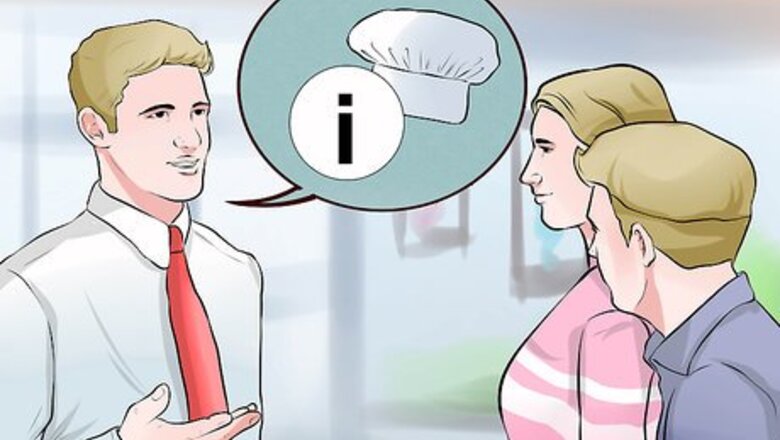
views
Teaching Your Employees
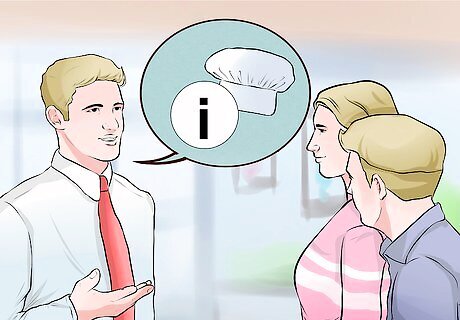
Hold an orientation. Perhaps the first step you’ll need to take in training restaurant staff is to hold an orientation. In an orientation, you or your trainers will present basic information about your business, your practices, and everything relevant to your staff's basic performance of their job. More specifically the orientation will include: Human resource related information, payroll information, and any formalities staff will have to complete before they actually begin working. Your restaurant’s history and philosophy. This should include your philosophy on customer service. A brief tour of your restaurant's facility. An introduction to your management and other key staff such as trainers. An overview of the menu (and other services offered) and perhaps a tasting. An outline of the training process. Try getting to know the new employees that you're training, as everyone receives information differently. Some people learn best through visuals, others learn best through hearing, and others learn best by doing. By getting to know your employees, you can figure out the best way to relay new information to them.

Instruct and educate your staff. After orientation, restaurant staff should begin the training process. In the training process, you or your trainers will instruct and educate new staff about important elements of their day-to-day work. Ultimately, instruction and education is the foundation of your employee's training and will provide them with the tools they need to go forward and succeed. This is your opportunity to focus on the particularities of different roles in your restaurant, including: Food prep work. Chef and cook work. Bartending. Dishwashing and busing. Hosting and greeting. Waiting.
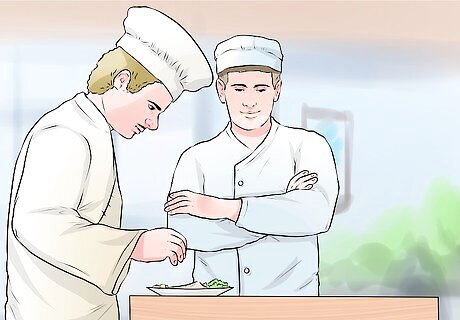
Make your staff observe and assist experienced employees. One of the best ways to teach your staff is to have them observe and assist the most experienced staff in your restaurant. This way, not only will your experienced staff be able to train and teach your new staff, but the new staff will be able to see common practices and less-used practices that your trainers might not typically teach them. Pair your new staff with seasoned staff and have the new staff follow, observe, and assist the seasoned staff for a period of time. The observe and assist period can last anywhere from a few days to a week or more. Instruct your seasoned staff to go about their work as they typically do. Instruct your new staff and the seasoned staff to engage in dialogue throughout the shift and at the end of the shift. New staff should ask as many questions as possible and seasoned staff should answer without hesitation. If time permits, have them shadow employees in other important positions to give them a better understanding of how the whole restaurant team works. Obviously, your current staff have to be good if they're employed under you for a long time. This makes them perfect for training new staff members.

Communicate with your staff. No one will be better able to understand what's most important for a new restaurant employee to know than your veteran staff members. Take advantage of their experience and talk to them about different and innovative ways of training new hires. Ideas can include: Problems staff sees with current training programs. Suggestions staff have for new training approaches. Any other suggestions the staff has to improve organizational effectiveness.
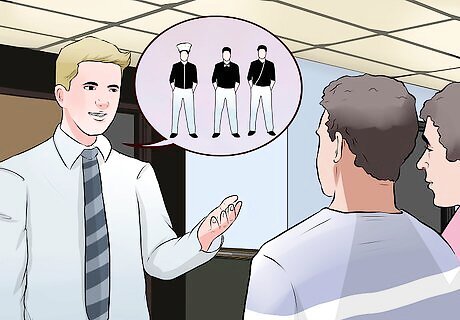
Teach new employees about all positions. Give new restaurant employees training in all the positions in the restaurant. Have them spend time on the food line, behind the bar if legally permissible, with the dishwashers and working with the host or hostess to greet and seat diners. This will help them become more flexible in their duties and give them a better understanding of what it takes to run the restaurant successfully.

Prioritize safety. While there will be a lot of important information to cover with your new hires, food and occupational safety should always take top priority. Emphasize these areas as they pertain to the new hires' positions and the restaurant as a whole. Review safety procedures and rules throughout the training process to ensure they're understood. Make sure to cover: How to handle food. How to store food and clean preparation items. Safety precautions when using machinery or food preparation equipment. The way to properly move around the restaurant (i.e. don’t run).
Reinforcing Best Practices

Set a good example. Train restaurant employees by setting a good example for them with your own behavior. As the boss, you're always being observed by employees, and new hires will especially look to you for the right way to conduct themselves. Keep this in mind when you work with other members of the wait staff, vendors and diners and conduct yourself courteously and professionally.

Hold regular training refreshers. Training should not stop soon after an employee joins your staff. In order to reinforce best practices, you should hold training sessions regularly. This will not only help your staff recall everything you’ve covered before, but will act as an opportunity to train seasoned staff in new techniques and approaches. Use regular training events as an opportunity to train staff on new techniques and changes to your restaurant. This will be especially important if you have a menu change. Use regular training events as an opportunity to bring in outside trainers who utilize different techniques than you have used in the past. Use regular training events as an opportunity to retrain and refresh seasoned staff who are becoming set in their ways or even careless.

Hold meetings with your employees. Holding meetings with your employees – whether it be a group meeting or individual meetings – is one of the best ways to reinforce best practices. Meetings don’t necessarily have to address staff weaknesses or bad things. Use meetings as an opportunity to lead by example and to highlight what you want your staff to do to improve your business and the customer experience. Focus on your staff’s strengths, and encourage them to live up to these strengths and emulate each other’s positive qualities. Hold semi-regular group meetings every 2-3 months, at a minimum. Hold one-on-one meetings with employees you think are falling behind. Use this as an opportunity to discuss performance evaluations and to encourage them to live up to their abilities. Hold one-on-one meetings with employees you think are doing a great job. Talk about their good qualities and let them know that their work has been noticed.
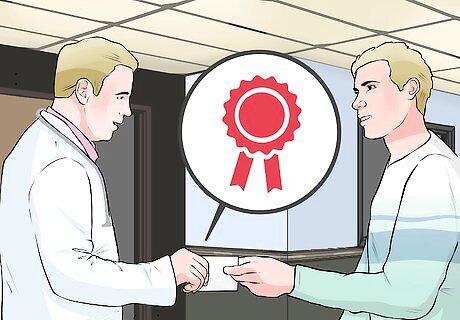
Recognize your best employees. Reinforcing best practices is not just about training and teaching, it is also about recognizing your employees who do outstanding jobs. By recognizing these employees, you’ll send the message that you are paying attention and that their efforts are being noticed. Consider: Recognizing your top employees at regular meetings. Recognizing top employees in a private meeting. Recognizing top employees through social media. Giving top employees awards or cash bonuses.
Observing Your Employees
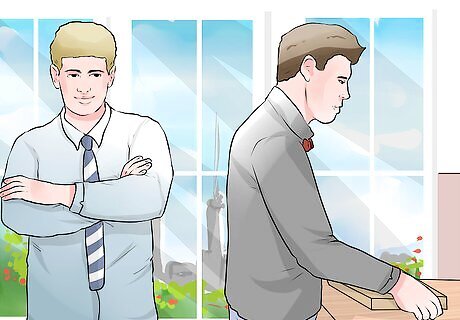
Watch your employees. While you had your new staff shadow seasoned employees earlier in the training process, now it is time to watch your employees to see how they’ve internalized all of the training they’ve gone through. Spend some time every day watching or overseeing different members of your staff. When doing this: Inform staff in advance that this might be done as part of a schedule or even randomly. Don’t spend too much time. Fifteen minutes or less might suffice. Consider positioning yourself at a central location to watch or shadow your employees. To be less obvious, simply slow down your normal rounds of the restaurant. Walk slowly, greeting customers who are dining, and observing how your staff is interacting with each other and the customers.

Use mystery diners. Mystery shoppers, diners, or customers are frequently used in the restaurant and retail industry as a way of collecting information about customer service and employee efficiency. In the restaurant industry, mystery diners are people who are employed to eat at a restaurant and evaluate the restaurants service, food quality, and overall experience without employees knowing that they are being evaluated. Mystery diners will give you important information about the efficacy of your training program and your restaurant's overall customer service. Hire a third party business that specializes in evaluating businesses like your own. They will send mystery diners and then provide you with detailed feedback. Have a friend or family member patronize your restaurant and evaluate it without your employees' knowledge. Use mystery diners on a regular but random basis so you can continually gather feedback about your training success and customer service.

Conduct performance reviews. Performance reviews are an extremely important way of tracking an employee’s progress toward becoming a valued member of your restaurant staff. When conducted by a manager or senior trainer or staff member, performance reviews can be used to evaluate everything from efficiency, attitude, customer service, and other strengths and weaknesses. Consider conducting performance reviews or evaluations every 6 months to a year on seasoned employees. Conduct performance reviews or evaluations on new staff members 1 to 3 months after they’ve completed training. Rotate the senior staff and managers who conduct performance reviews on any one individual.
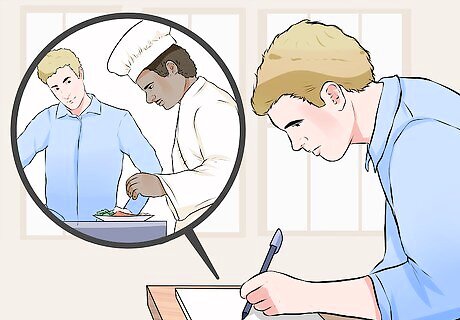
Keep records based on your observations. While observations are extremely important, keeping records of your observations will help you when it comes time to implement staff changes and new training approaches. As a result, always keep well-organized records of everything having to do with your employee observations. Consider: Logging tardiness and missed work. Creating a file for each staff member and filing all relevant information there. Take brief notes periodically about your employees' weaknesses and strengths. This might help when training comes around or when it’s time to discuss performance reviews.




















Comments
0 comment